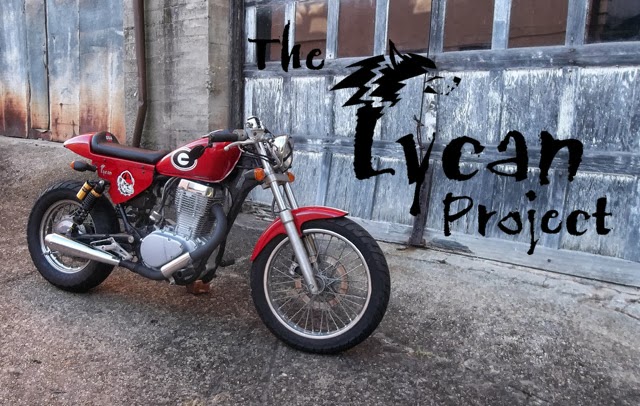While the bike is apart for painting I decided to replace the fork seals. Since the forks will be apart it also makes sense to lower the front forks at this time. RYCA makes spacers that can be inserted onto the fork cylinders above the springs which result in taking the fork tubes and pushing them 2 inches further into the fork lowers. This results in decreasing the effective rake and trail of the bike. It decreases front travel from 5.5 inches to 3.5 inches. By not trimming the spacers or changing the springs the fork is much firmer due to the preloaded compression on the spring. The diagram below shows the lowered fork tube in pink and the location of the lowering spacer in neon green.

Two very important tools for this procedure can be made from parts purchased from your local hardware store. The fork tool, on the left, can be made by purchasing 1 24" section of 3/8 threaded rod and 4 hex head nuts. The nuts are threaded onto each end and locked into place by tightening the nuts against each other. The other piece is a 24" long section of 1.5 inch pvc. This is used to seat the oil seals when reassembling the forks.
The fork should be locked into some form of soft jawed clamping device. I used an inexpensive work aid that I replaced the jaws with 2X4's some years ago. this is necessary because the bolt on the bottom holding the cylinder in place is very very tight. Insert the threaded rod into the fork until the hex nut locks in the top of the cylinder. Insert a 8mm extended reach hex key into the bolt on the bottom of the fork. I used a cheater bar (3/8 square steel tube 18" long) on the hex key to enable me to loosen the bolt.
.jpg)
Be sure not to lose the brass crush washer on the bottom bolt. Once this is done you can remove the cylinder and spring by inverting the fork. It's messy so have a rag handy. Take a small flat head screw driver and pry up the dust cover and slide it off the fork tube. Then take a small flat head screw driver and remove the seal retaining clip above the fork seal. At this point you can remove the tube from the lower by compressing and then pulling apart the top and bottom halves of the forks. This may take several tries to separate the two halves. Once apart the upper portion has the seal, a washer, and a metal slide in that order. Remove the seal only taking note of the orientation of the seal on the tube. Slide the new seal on the tube in the same manner as the one you just removed.
Take the cylinder and remove the spring, slide the lowering spacer on and then the spring as pictured below.
Reinsert the top tube into the fork lower and insert the cylinder with the spacer and spring. Insert the removal tool and the bolt on the bottom with the spacer and tighten securely.
Slide the fork seal into place in the fork lower, using the 1.5 in. PVC tap the seal into place until the groove is visible for the retaining spring.
Replace the spring and make sure it is seated securely into the groove.
Then replace the dust cover.
Repeat for the other fork and you are ready to reassemble the forks on the bike. Once the forks are back in the triple trees, insert the springs and then the washers in each tube. Now compress each fork, the washers should be just below the top of the fork. either use ATF Dexron or 15W fork oil. Use 15 oz. of either oil. 15 oz. should fill the compressed fork to the top. Then extend the forks and insert the spacers. The spacers should extend 2 inches above the top of the tube. This is the hard part! Really! Replace the top caps and while compressing the spacer into the fork turn the top cap until it begins to catch the threads and then tighten. This is pretty difficult and may require two people and quite an extensive vocabulary of vulgar language to accomplish correctly. If you do not have a helper it may also require two or three trips to the hardware store and the purchase of a 27 mm socket to complete the job. Just my experience yours may go better.
Before.
After!
When I measured the trail with laser levels before it was 5 inches.
After installing the spacers, using the same procedure as before it measures 4 inches now. That is actually a really good number.
I found the data somewhere that the RYCA CS-1 has a trail of 4.75 inches and a rake of 29 degrees. The stock LS650 is 5.65 inches of trail and 35 degrees of rake. Based on what I have read the way I measured the trail is about as accurate as I can get. I'm going with 4 inches. With the rejetted carb and the lowered front I'm really looking forward to riding the bike when I get the parts back from painting.
My only concern at this point is the tank and how far out of level it will be. The petcock is in the rear and this may be a problem or maybe not.


.jpg)
.jpg)
.jpg)
.jpg)
.jpg)
.jpg)
.jpg)
.jpg)
.jpg)
.jpg)
.jpg)
.jpg)
.jpg)
.jpg)
.jpg)
.jpg)
.jpg)
.jpg)
.jpg)
.jpg)

.jpg)
.jpg)
.jpg)
.jpg)
.jpg)
.jpg)
.jpg)
.jpg)
.jpg)
.jpg)
.jpg)
.jpg)
.jpg)
.jpg)
.jpg)
.jpg)
.jpg)
.jpg)
.jpg)
.jpg)
.jpg)
.jpg)
.jpg)
.jpg)